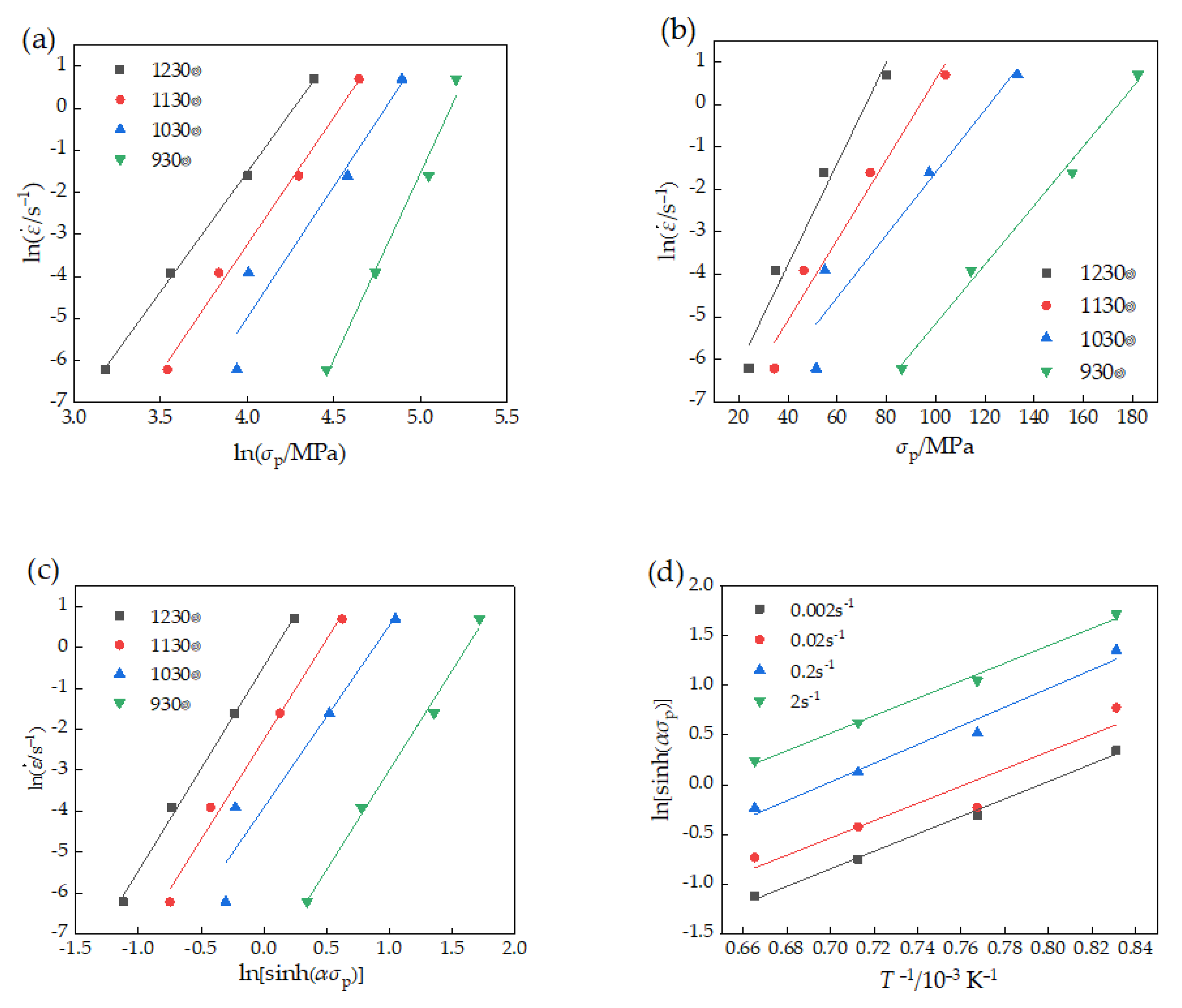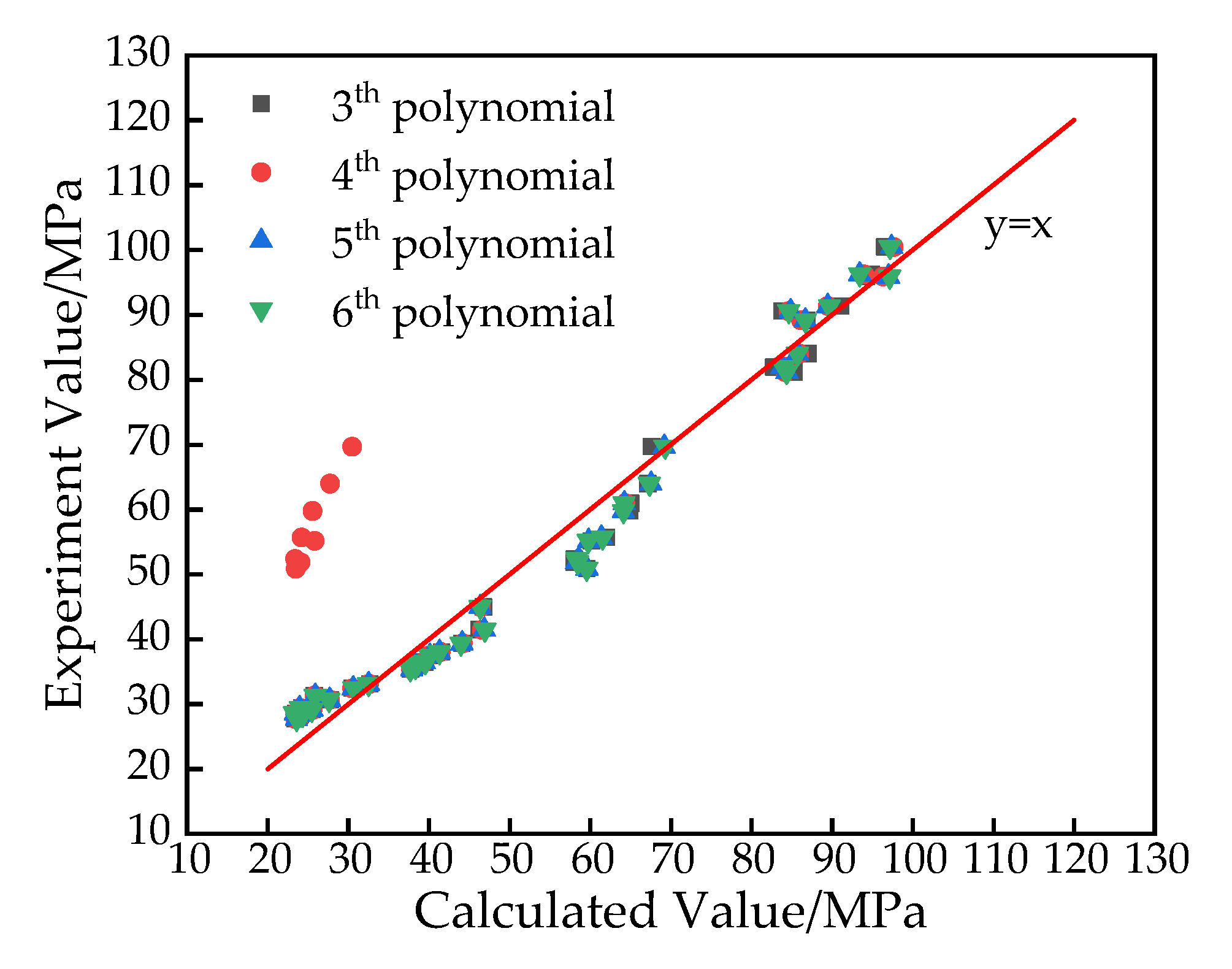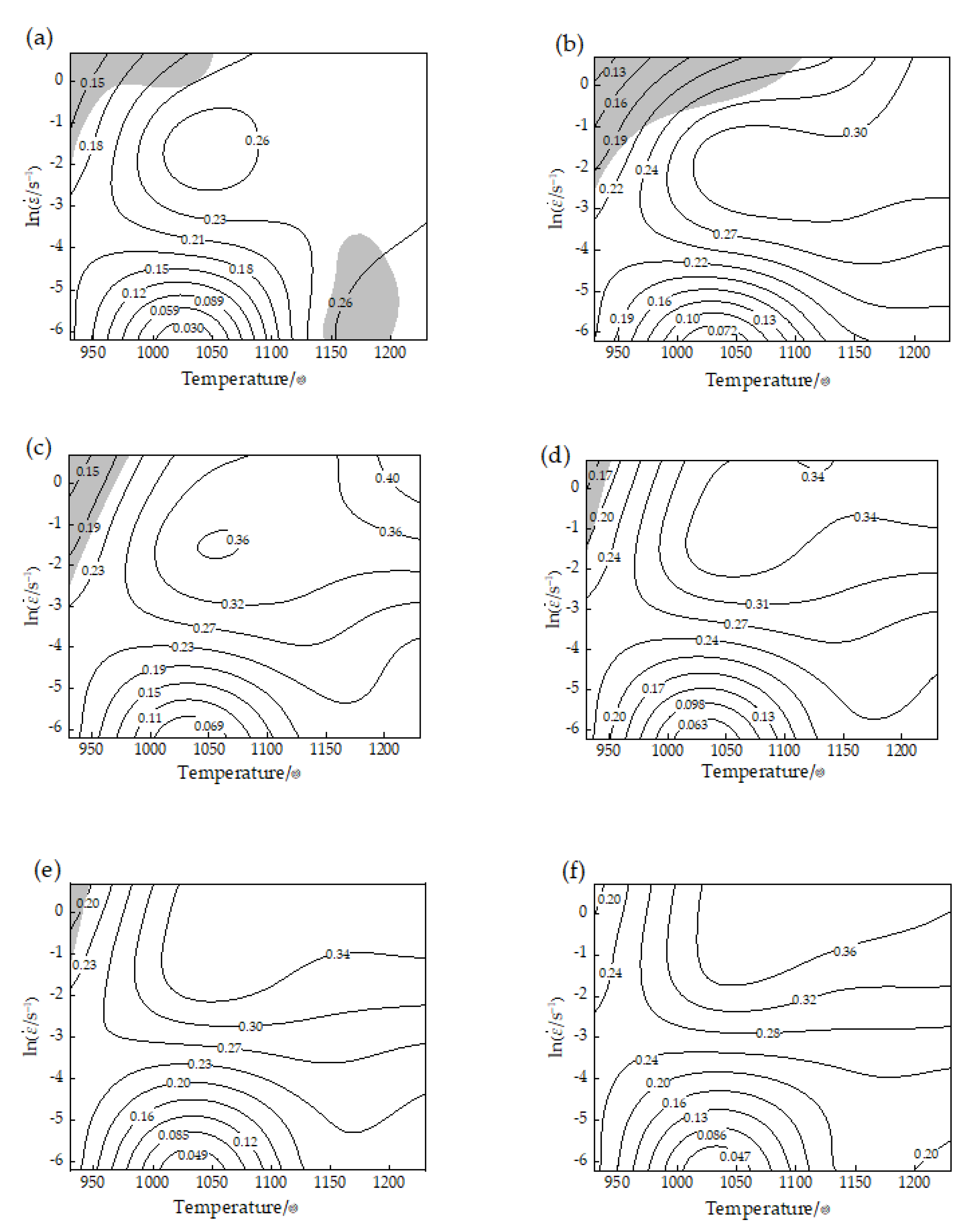Strain Modified Constitutive Equation and Processing Maps of High Quality 20MnCr5(SH) Gear Steel
Abstract
1. Introduction
2. Materials and Experimental Procedure
3. Results and Analysis
3.1. Flow Stress Curve Analysis
3.2. Microstructure Observation
4. Establishment and Verification of Modified Constitutive Equation
5. Processing Maps
6. Conclusions
- (1)
- The higher the hot deformation temperature of 20MnCr5(SH) gear steel is, the smaller the flow stress is, and vice versa; the lower the strain rate is, the smaller the flow stress is, and vice versa. The observation of metallographic structure shows that dynamic recrystallization occurs during hot deformation of 20MnCr5(SH) gear steel. The austenite grains are filled with martensite lath bundles.
- (2)
- According to the true stress-strain curve, the parameters of the constitutive equation are obtained by linear fitting method, and the 20MnCr5(SH) constitutive equation is obtained. The thermal deformation activation energy Qact of 20MnCr5(SH) is 356.412 kJ/mol, and the strain rate sensitivity index n is 4.802. Dynamic recovery and dynamic recrystallization are the main softening mechanisms of 20MnCr5(SH).
- (3)
- The strain modified constitutive equation of 20MnCr5(SH) is established. The material constants (α, n, Qact, lnA) involved in the constitutive equation are fitted by five polynomial. The flow stress calculated by strain modified constitutive equation is compared with the measured value of thermal pressure test. The correlation R = 0.9895, and the average relative error is 8.048%. It shows that the strain modified constitutive equation has strong stress prediction ability.
- (4)
- Based on the dynamic material model and the instability criterion, the processing maps of strain ε = 0.1, 0.2, 0.3, 0.4, 0.5 and 0.6 are established. The results show that the best processing parameters of 20MnCr5(SH) gear steel are strain rate 0.05 s−1–1 s−1, temperature 1030–1100 °C. In this region, the plastic instability region can be avoided and the power dissipation rate is large.
Author Contributions
Funding
Institutional Review Board Statement
Informed Consent Statement
Data Availability Statement
Conflicts of Interest
References
- Trausmuth, A.; Godor, I.; Grün, F. Phenomenological wear model of case-hardened 20MnCr5 under cyclic line rolling contact. Wear 2021, 470–471, 203607. [Google Scholar] [CrossRef]
- Damon, J.; Mühl, F.; Dietrich, S.; Schulze, V. A Comparative Study of Kinetic Models Regarding Bainitic Transformation Behavior in Carburized Case Hardening Steel 20MnCr5. Met. Mater. Trans. A 2018, 50, 104–117. [Google Scholar] [CrossRef]
- Ayyappan, S.; Sivakumar, K. Investigation of electrochemical machining characteristics of 20MnCr5 alloy steel using potassium dichromate mixed aqueous NaCl electrolyte and optimization of process parameters. Proc. Inst. Mech. Eng. Part B J. Eng. Manuf. 2014, 229, 1984–1996. [Google Scholar] [CrossRef]
- Yang, M.; Sisson, R.D. Carburizing Heat Treatment of Selective-Laser-Melted 20MnCr5 Steel. J. Mater. Eng. Perform. 2020, 29, 3476–3485. [Google Scholar] [CrossRef]
- Chen, X.; Liao, Q.; Niu, Y.; Jia, W.; Le, Q.; Cheng, C.; Yu, F.; Cui, J. A constitutive relation of AZ80 magnesium alloy during hot deformation based on Arrhenius and Johnson–Cook model. J. Mater. Res. Technol. 2019, 8, 1859–1869. [Google Scholar] [CrossRef]
- Li, T.; Zhao, B.; Lu, X.; Xu, H.; Zou, D. A Comparative Study on Johnson Cook, Modified Zerilli–Armstrong, and Arrheni-us-Type Constitutive Models to Predict Compression Flow Behavior of SnSbCu Alloy. Materials 2019, 12, 1726. [Google Scholar] [CrossRef]
- Yang, J.C.; Wang, P.T.; Wang, L.Z.; Zhou, Z.J. Study on warm precision forging method of integral combined gear. J. Xinjiang Univ. 2020, 37, 384–388. [Google Scholar] [CrossRef]
- Wang, S.; Liang, Y.; Wei, S.; Guo, Y.; Xu, B. High temperature flow behavior and constitutive model of alloy transition layer in composite steel tube prepared by centrifugal self-propagating high-temperature synthesis (SHS). Mater. Werkst. 2020, 51, 1412–1422. [Google Scholar] [CrossRef]
- Zhao, H.; Qi, J.; Su, R.; Zhang, H.; Chen, H.; Bai, L.; Wang, C. Hot deformation behaviour of 40CrNi steel and evaluation of different processing map construction methods. J. Mater. Res. Technol. 2020, 9, 2856–2869. [Google Scholar] [CrossRef]
- Lei, B.; Chen, G.; Liu, K.; Wang, X.; Jiang, X.; Pan, J.; Shi, Q. Constitutive Analysis on High-Temperature Flow Behavior of 3Cr-1Si-1Ni Ultra-High Strength Steel for Modeling of Flow Stress. Metals 2019, 9, 42. [Google Scholar] [CrossRef]
- Ye, L.; Zhai, Y.; Zhou, L.; Wang, H.; Jiang, P. The hot deformation behavior and 3D processing maps of 25Cr2Ni4MoV steel for a super-large nuclear-power rotor. J. Manuf. Process. 2020, 59, 535–544. [Google Scholar] [CrossRef]
- Jia, X.-D.; Wang, Y.-N.; Zhou, Y.; Cao, M.-Y. The Study on Forming Property at High Temperature and Processing Map of 2219 Aluminum Alloy. Metals 2021, 11, 77. [Google Scholar] [CrossRef]
- Cai, X.; Hu, X.Q.; Zheng, L.G.; Li, D.Z. Hot Deformation Behavior and Processing Maps of 0.3C-15Cr-1Mo-0.5N High Ni-trogen Martensitic Stainless Steel. Acta Metall. Sin. Engl. Lett. 2020, 33, 693–704. [Google Scholar] [CrossRef]
- Srinivasan, R.; Natarajan, S.; Sivakumar, V. Fatigue life improvement on 20MnCr5 steel through surface modification for auto transmission application. Arch. Civ. Mech. Eng. 2019, 19, 360–374. [Google Scholar] [CrossRef]
- Hostos, J.Á.; Bencomo, A.; Cabrera, E.P.; Guerin, J.-D.; Dubar, L. Modeling the viscoplastic flow behavior of a 20MnCr5 steel grade deformed under hot-working conditions, employing a meshless technique. Int. J. Plast. 2018, 103, 119–142. [Google Scholar] [CrossRef]
- Ramesh, S.; Natarajan, S.; Sivakumar, V.J. Effect of Surface Condition on the Torsional Fatigue Behaviour of 20MnCr5 Steel. Met. Mater. Int. 2020, 1–11. [Google Scholar] [CrossRef]
- Puchi-Cabrera, E.S.; Guérin, J.-D.; Dubar, M.; Staia, M.H.; Lesage, J.; Chicot, D. Constitutive description for the design of hot-working operations of a 20MnCr5 steel grade. Mater. Des. 2014, 62, 255–264. [Google Scholar] [CrossRef]
- Zhang, C.; Zhang, L.; Shen, W.; Liu, C.; Xia, Y.; Li, R. Study on constitutive modeling and processing maps for hot deformation of medium carbon Cr–Ni–Mo alloyed steel. Mater. Des. 2016, 90, 804–814. [Google Scholar] [CrossRef]
- Sellars, C.; McTegart, W. On the mechanism of hot deformation. Acta Met. 1966, 14, 1136–1138. [Google Scholar] [CrossRef]
- Song, S.-H. A Comparison Study of Constitutive Equation, Neural Networks, and Support Vector Regression for Modeling Hot Deformation of 316L Stainless Steel. Materials 2020, 13, 3766. [Google Scholar] [CrossRef]
- Wu, H.; Xu, W.; Wang, S.; Yang, Z.; Chen, Y.; Teng, B.; Shan, D.; Guo, B. A cellular automaton coupled FEA model for hot deformation behavior of AZ61 magnesium alloys. J. Alloys Compd. 2020, 816, 152–562. [Google Scholar] [CrossRef]
- Shi, H.; Mclaren, A.J.; Sellars, C.M.; Shahani, R.; Bolingbroke, R. Constitutive equations for high temperature flow stress of aluminium alloys. Met. Sci. J. 1997, 13, 210–216. [Google Scholar] [CrossRef]
- Zener, C.; Hollomon, J.H. Effect of stain-rate upon the plastic flow of steel. J. Appl. Phys. 1944, 1, 22–32. [Google Scholar] [CrossRef]
- Xiao, Z.; Wang, Q.; Huang, Y.; Hu, J.; Li, M. Hot Deformation Characteristics and Processing Parameter Optimization of Al–6.32Zn–2.10Mg Alloy Using Constitutive Equation and Processing Map. Metals 2021, 11, 360. [Google Scholar] [CrossRef]
- Zhao, Y.; Ding, H.; Cao, Y.; Chen, P.; Hu, Z.; Zhang, J.; Li, L. Hot Processing Map of an Al–4.30 Mg Alloy under High One-Pass Deformation. Metals 2021, 11, 347. [Google Scholar] [CrossRef]
- Pan, D.; Liu, B.; Xu, R.; Qiu, J.; Liu, C. Predicting Workability of a Low-Cost Powder Metallurgical Ti–5Al–2Fe–3Mo Alloy Using Constitutive Modeling and Processing Map. Materials 2021, 14, 836. [Google Scholar] [CrossRef]
- Prasad, Y.; Seshacharyulu, T. Processing maps for hot working of titanium alloys. Mater. Sci. Eng. A 1998, 243, 82–88. [Google Scholar] [CrossRef]
- Prasad, Y.V.R.K. Processing Maps: A Status Report. J. Mater. Eng. Perform. 2003, 12, 638–645. [Google Scholar] [CrossRef]
- Murty, S.V.S.N.; Rao, B.N. On the development of instability criteria during hot working with reference to IN718. Mater. Sci. Eng. A 1998, 254, 76–82. [Google Scholar] [CrossRef]
- Zhong, J.; Xu, Q. High-Temperature Mechanical Behaviors of SiO2-Based Ceramic Core for Directional Solidification of Turbine Blades. Materials 2020, 13, 4579. [Google Scholar] [CrossRef]
- Cao, L.; Liao, B.; Wu, X.; Li, C.; Huang, G.; Cheng, N. Hot Deformation Behavior and Microstructure Characterization of an Al-Cu-Li-Mg-Ag Alloy. Crystals 2020, 10, 416. [Google Scholar] [CrossRef]
- Murugesan, M.; Sajjad, M.; Jung, D.W. Microstructure Evaluation and Constitutive Modeling of AISI-1045 Steel for Flow Stress Prediction under Hot Working Conditions. Symmetry 2020, 12, 782. [Google Scholar] [CrossRef]
- Bao, C.; Zhou, T.; Shi, L.; Li, M.; Hu, L.; Yang, M.; Chen, Q. Hot Deformation Behavior and Constitutive Analysis of As-Extruded Mg–6Zn–5Ca–3Ce Alloy Fabricated by Rapid Solidification. Metals 2021, 11, 480. [Google Scholar] [CrossRef]










| C | Si | Mn | P | S | Cr | Si | Al | Cu |
|---|---|---|---|---|---|---|---|---|
| 0.17–0.22 | ≤0.12 | 1.00–1.50 | ≤0.035 | 0.01–0.035 | 0.80–1.30 | ≤0.12 | 0.02–0.04 | ≤0.20 |
| /s | 930 °C | 1030 °C | 1130 °C | 1230 °C |
|---|---|---|---|---|
| 0.002 | 0.17765 | 0.09375 | 0.07893 | 0.05331 |
| 0.02 | 0.24110 | 0.14195 | 0.11200 | 0.10092 |
| 0.2 | 0.26796 | 0.19074 | 0.19030 | 0.14090 |
| 2 | 0.35066 | 0.25377 | 0.27823 | 0.21607 |
| Order | R | AARE (%) |
|---|---|---|
| 3 | 0.9884 | 8.184 |
| 4 | 0.9121 | 18.298 |
| 5 | 0.9895 | 8.048 |
| 6 | 0.9894 | 8.052 |
| 0 | 1 | 2 | 3 | 4 | 5 | |
|---|---|---|---|---|---|---|
| B | 0.0183 | −0.0599 | 0.2261 | −0.3413 | 0.2348 | −0.0633 |
| C | 7.6297 | −23.2061 | 67.5240 | −98.6714 | 70.6542 | −18.6440 |
| D | 39.9165 | −99.8983 | 395.4466 | −757.2713 | 688.5364 | −238.0469 |
| F | 490.3597 | −1187.4711 | 4549.0954 | −8382.6452 | 7348.1034 | −2457.3164 |
| ε | /s−1 | T/°C | |||
|---|---|---|---|---|---|
| 930 | 1030 | 1130 | 1230 | ||
| 0.1 | 0.002 | 0.0997 | 0.0010 | 0.1327 | 0.1715 |
| 0.02 | 0.1015 | 0.1086 | 0.1325 | 0.1564 | |
| 0.2 | 0.0827 | 0.1653 | 0.1358 | 0.1428 | |
| 2 | 0.0621 | 0.1145 | 0.1394 | 0.1443 | |
| 0.2 | 0.002 | 0.1199 | 0.0218 | 0.1071 | 0.1267 |
| 0.02 | 0.1247 | 0.1432 | 0.1662 | 0.1579 | |
| 0.2 | 0.0948 | 0.1884 | 0.1821 | 0.1925 | |
| 2 | 0.0601 | 01120 | 0.1388 | 0.1959 | |
| 0.3 | 0.002 | 0.1438 | 0.0144 | 0.1085 | 0.1231 |
| 0.02 | 0.1423 | 0.1361 | 0.1599 | 0.1292 | |
| 0.2 | 0.1025 | 0.2124 | 0.2036 | 0.2073 | |
| 2 | 0.0641 | 0.1671 | 0.1958 | 0.2793 | |
| 0.4 | 0.002 | 0.1436 | 0.0142 | 0.1155 | 01275 |
| 0.02 | 0.1472 | 0.1268 | 0.1559 | 0.1411 | |
| 0.2 | 0.1161 | 0.2186 | 0.2017 | 0.1945 | |
| 2 | 0.0813 | 0.1978 | 0.2070 | 0.2342 | |
| 0.5 | 0.002 | 0.1449 | 0.0064 | 0.1099 | 0.1111 |
| 0.02 | 0.1551 | 0.1172 | 0.1468 | 0.1374 | |
| 0.2 | 0.1265 | 0.2205 | 0.1994 | 0.1958 | |
| 2 | 0.0877 | 0.2130 | 0.2150 | 0.2279 | |
| 0.6 | 0.002 | 0.1447 | 0.0045 | 0.1109 | 0.1044 |
| 0.02 | 0.1475 | 0.1086 | 0.1321 | 0.1341 | |
| 0.2 | 0.1277 | 0.2202 | 0.1985 | 0.1940 | |
| 2 | 0.1050 | 0.2276 | 0.2437 | 0.2242 | |
Publisher’s Note: MDPI stays neutral with regard to jurisdictional claims in published maps and institutional affiliations. |
© 2021 by the authors. Licensee MDPI, Basel, Switzerland. This article is an open access article distributed under the terms and conditions of the Creative Commons Attribution (CC BY) license (https://creativecommons.org/licenses/by/4.0/).
Share and Cite
Yang, J.; Wang, L.; Zheng, Y.; Zhong, Z. Strain Modified Constitutive Equation and Processing Maps of High Quality 20MnCr5(SH) Gear Steel. Crystals 2021, 11, 536. https://doi.org/10.3390/cryst11050536
Yang J, Wang L, Zheng Y, Zhong Z. Strain Modified Constitutive Equation and Processing Maps of High Quality 20MnCr5(SH) Gear Steel. Crystals. 2021; 11(5):536. https://doi.org/10.3390/cryst11050536
Chicago/Turabian StyleYang, Jingcheng, Lizhong Wang, Yingjun Zheng, and Zhiping Zhong. 2021. "Strain Modified Constitutive Equation and Processing Maps of High Quality 20MnCr5(SH) Gear Steel" Crystals 11, no. 5: 536. https://doi.org/10.3390/cryst11050536
APA StyleYang, J., Wang, L., Zheng, Y., & Zhong, Z. (2021). Strain Modified Constitutive Equation and Processing Maps of High Quality 20MnCr5(SH) Gear Steel. Crystals, 11(5), 536. https://doi.org/10.3390/cryst11050536





